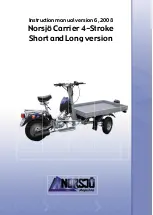
1-4
Break-In Procedure
A new ATV and an overhauled ATV engine require
a “break-in” period. The first 10 hours (or 200
miles) are most critical to the life of this ATV.
Proper operation during this break-in period will
help assure maximum life and performance from the
ATV.
During the first 10 hours (or 200 miles) of opera-
tion, always use less than 1/2 throttle. Varying the
engine RPM during the break-in period allows the
components to “load” (aiding the mating process)
and then “unload” (allowing components to cool).
Although it is essential to place some stress on the
engine components during break-in, care should be
taken not to overload the engine too often. Do not
pull a trailer or carry heavy loads during the 10-hour
break-in period.
When the engine starts, allow it to warm up prop-
erly. Idle the engine several minutes until the engine
has reached normal operating temperature. Do not
idle the engine for excessively long periods of time.
During the break-in period, a maximum of 1/2 throt-
tle is recommended; however, brief full-throttle
accelerations and variations in driving speeds con-
tribute to good engine break-in.
During the break-in period (or whenever the brake
pads are replaced), the hydraulic brake pads must be
burnished. Slow disc-speed hydraulic brakes must
be properly burnished in order to achieve maximum
stopping power.
NOTE: Do not be reluctant to heat up the brake
pads during the burnishing procedure.
After the completion of the break-in period, the
engine oil and oil filter should be changed. Other
maintenance after break-in should include checking
of all prescribed adjustments and tightening of all
fasteners.
Gasoline - Oil -
Lubricant
RECOMMENDED GASOLINE
The recommended gasoline to use is 87 minimum
octane regular unleaded. In many areas, oxygenates
(either ethanol or MTBE) are added to the gasoline.
Oxygenated gasolines containing up to 10% ethanol,
5% methane, or 5% MTBE are acceptable gasolines.
When using ethanol blended gasoline, it is not nec-
essary to add a gasoline antifreeze since ethanol will
prevent the accumulation of moisture in the fuel sys-
tem.
RECOMMENDED ENGINE OIL
The recommended oil to use is Arctic Cat 4-Cycle
Engine Oil or an equivalent oil which is rated SE,
SF, or SG under API service classification. These
oils meet all of the lubrication requirements of the
Arctic Cat ATV engine. The recommended engine
oil viscosity is SAE 5W-30. Ambient temperature
should determine the correct weight of oil. See the
following viscosity chart for details.
! CAUTION
BRAKE PADS MUST BE BURNISHED TO ACHIEVE
FULL BRAKING EFFECTIVENESS. Braking dis-
tance will be extended until brake pads are properly
burnished.
TO PROPERLY BURNISH THE BRAKES, USE FOL-
LOWING PROCEDURE:
• Choose an area sufficiently large to safely accel-
erate ATV to 30 mph and to brake to a stop.
• Accelerate to 30 mph; then compress brake
lever to decelerate to 0-5 mph.
• Repeat procedure five times until brakes are bur-
nished.
• This procedure burnishes the brake pads, stabi-
lizes the pad material, and extends the life of the
brake pads.
! WARNING
Do not attempt sudden stops or put the ATV into a
situation where a sudden stop will be required until
the brake pads are properly burnished.
! CAUTION
Do not use white gas. Only Arctic Cat approved
gasoline additives should be used.
! CAUTION
Any oil used in place of the recommended oil could
cause serious engine damage. Do not use oils
which contain graphite or molybdenum additives.
These oils can adversely affect clutch operation.
Also, not recommended are racing, vegetable, non-
detergent, and castor-based oils.
Back to TOC
Back to Section TOC
Next
Back
Содержание DVX 250 2007
Страница 1: ......







































